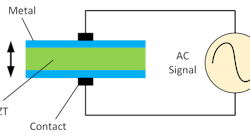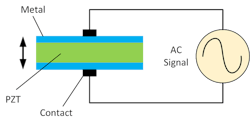Jacques and Pierre Curie, French physics, discovered the piezoelectric effect in 1880. When some solid material is mechanically compressed or stressed, the material accumulates electrical charges on its surface and develops a voltage potential. This is the piezoelectric effect. The inverse piezoelectric effect is when the process occurs in reverse. When voltage potential is applied to certain ceramic materials, they expand and contract physically as shown in Figure 1.
1. An ac sinewave applied to a piezo device causes the material to expand and contract.
Comments
Comments

